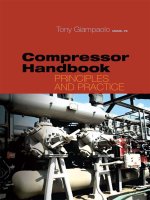Ebook Interior design principles and practice - M. Pratap Rao: Phần 2
Bạn đang xem bản rút gọn của tài liệu. Xem và tải ngay bản đầy đủ của tài liệu tại đây (44.51 MB, 125 trang )
I. LETTERING
All the headings, explanatory notes and dimensions should be neatly written on the drawing. Ordinary writing is not good for presentation. A student c'
interior design should devote enough time to practice lettering before starting the drawing. To do good lettering, the work must be done slowly. The present
lettering style is known as single-stroke lettering. Other styles of lettering\can also be used but this is an easy and acceptable form of lettering. In
single-stroke lettering a line of the required thickness is made with one stroke. The letters must be well formed with good relative width and uniform spacing.
There is no standard relation between the height and the width of a particular letter. The actual width of the letter will depend on the space available for
writing. Proper proportions of the various letters are estimated by eye. The rounded letters require most care and attention. Good jqdgement and practise are
required to obtain proper spacing of the letters in a work.
Writing method
There are basically three types of letters normally used. They are:
I. Block letters like A, B, C .. . . . .
2. Small letters like a, b, c . . . . . .
3. Numbers like I, 2, 3 . . . . . .
Try to write all the letters with free-hand with pencil grade 'B'. Avoid using T-square and set-squares for writing letters. Choose proper spacing between
the letters depending on the availability of space.
Steps
,
1. Block letters - Make rectangular boxes equally spaced with three horizontal lines as shown to any scale in the proportion of 1:1.5 (1 width and 1.5
length). Try to write all the letters within these boxes as shown. Take care in writing letters I, J & W proportionately because they may not fit exactly
in the box.
2. Small/etters - Ma~ rectangular boxes equally spaced with four horizontal lines as shown to any scale in the proportion of 1: 1.5 (1 width and 1.5
length). Try 'to write all the letters within these boxes as shown. Take care in writing letters i, j, m & w proportionately because they may not fit
exactly in the box.
3. NumIJers - Make rectangular boxes equally spaced with three horizootal lines to any scale in the proportion of 1:1.5 (1 width and 1.5 length). Try to
write all the numbers within the boxes as shown.
LETIERING
.
3
AND SCALES
2. SCALES
(a) British Units
r:\
(b) Metric Units
Drawing Method
.
Steps
..
.,
l. Take.~ ordinary 30 eentimeter~ (em) scale.
2. Mark upto 20 em.
...
J. For seale CDmark I 'em.as equivalent
=3
to 1 meter (m); 2 em
m; 3 em
= 3 m;
4 em
= 4 m;
5 em
= 5 m;
6 em
= 6 m; 7 em = 7 m;
8 em
= 8 m; 9
.
em
=9 m; 10em =.10 m; 11em = 11m; 12em = 12 m; 13em = 13 m; 14em = 14m; 15 em = 15 m; 16 em = 16 xn;17 em = 17 m;18 em = 18 m;
19 em = 1911\l;20em= 20 m ~d so pn. Now, it is a seale of 1 em
4. For scal~ @ n1.ark2.em as equivalent to 1 meter (m); 4 em
1~ em = 9 m;20
= 1 m (or) 1:100.
= 2 m; 6 em = 3 m; 8 em =4
em = 10 m; and s() on. Now, it is a seale of 2 em
=
=
= 1m
.
m; 10 em = 5 m; 12 em = 6 m; 14 em = 7 m; 16 em = 8 m;
(or) 1:50.
2 m; 15 em = 3 m; 20 em =4m and so on. Now it is a seale of 5 em = 1 m (or) 1:20.
6. For seale'@ mark 10 em as equivalent to 1 meter (m); 10 em 1 ni; 20 em = 2m and so on. Now, it is a seale of 10 em 1 m (or) 1:10.
7. For seale@ mark 20 em as equivalent to 1 pleter (m) and so on. Now, i.t is a seale of 20 em = 1 m (or) 1:5.
8. For seale @ mark 10 em as equi'(~eQ~to 3 meters; 5 em = 1.5 m; 4 em = 1.2 m; 3 em 0.90 m; 2 em 0.60 m; 1 em = 0.30 and based on this
5. For seale:;
=
.
higher digits should be worked out'. NQw, it is a seale of 10 em 3 meters (or) 1:30.
9. Simill!J'ly any type of $eale can. be made and u~ed for metrie units.
=
=
=
.
:- A. General assumptions
l. The followingobjectsare drawn:
.
L Square
2. Triangle
4. Hexagon
5. Circle
3. Rectangle
6. Octogan
2. Plan means appearance from the top of the object.
3. El€~vation means appearance from the side of the object.
4. Only one surface is seen at a time.
B. Object dimensions
I.
2.
3.
4.
The
The
The
The
square object has six. surfaces. They are top, bottom and four sides. Length: 2.50
triangular object has five surfaces. They are bottom and four sides. Length: 2:60
rectangular pbject has'six surfaces. They are top, bottom and four sides. Length:
hexagonal object has eight surfaces. They are top, bottom and six sides. Regular
m Width: 2.50 m. and Height: + 2.59 m.
m. Width: 2.60 m and Height: + 2.60 m.
2.50 m Width: 5.00 m and Height: + 2.50 m.
hexagon of 1.30 m. and height: + 2.50 m.
5. The circular object has three surfaces. They are top, bottom a.'ldside. Radius: 1.30 m and Height: + 2.50 m.
.
6. The. octagonal object has ten surfaces. They are top, bottom and eight sides. Regular octagon of 1.30 m. and height: + 3.00 m,
C. Drawing method
Steps
1. Visualise each surface how it appears on that particular side.
2. Draw plan to scale 1:100 (or) 1 em
1 meter as shown, otherwise choose any convenient scale.
=
A. General assumptions
1. The structure ;s standing on the ground level and all elevation heights are given from 'the ground level as + 1.2 m.:!t means 1.2 m. above the ground
level. Similarly + 3.7 m. means 3.7 m. from the ground level and -+4.9 m~\means 4.9 m. from the ground level. Normally all heights of any structure:
should be indicated as (+) or (-) from the ground level, which is treated ~:f: O.
2. The structure is composed of the following shapes:
(a) Rectangle of+ 1.2 m. height forms the b~e.
* On the left side:
(b) Square of + 3.7
(c) Diamond shape
(d) Square pyramid
* On the right side:
3. Three different views are marked as L (left),
m. height over the rectangular base.
of + 4.5 m. height over the squ~ base.
of + 4.9- m. height over the rectangular base.
F (front) and R (right):
B. Drawing method
Steps
1. Draw to scale. 1:100 (or) 1 cm
= 1 meter
as shown, otherwise'choose
any convenient scale.
2. Draw the plan as per the measurements.
,
3. Draw the 'F' side elevation directly below the plan so that orthographic projections ffom the plan can be t*en. Add the heights for the elevation.
4. Similarly draw 'L' and 'R' side elevations l'Qaintl,riniQga total height of + 4.9 m. f~m ground'1evel.
,
5. While drawing the elevations from three different sides, it should be observed that from each side elevation some parts of the structure are hi~den
and some are seen. Whenever an elevation is
!
Drawing Method
Steps
1. Draw to scale I: 100 (or) 1 cm
= 1 meter
as shown, otherwise choose any convenient scale.
2. The structure is composed of the following shapes:
(a) Rectangle of + 1.2 m. height forms the base.
(b) Regular octagon of + 2.4 m. height over the rectangular base.
(c) Square shaped' pyramid of + 5.00 m. height over the octagon
On
the
right
side:
(d) Square of + 5.00 m height over the rectangular base.
*
3. Draw the plan as per the measurements.
4. Draw the 'F' side elevation directly below the, plan so that orthographic projections from the plan can be taken. Add the heights for the elevation.
5. Similarly, draw 'L' and 'R' side elevations maintaining a total height of + 5.00 m from the ground level.
INTERIOR DESIGN
12
PRINCIPLES AND PRACTICE
(d) Table at Chair
Table and chair are the most commonly used furniture in interiors, so drawing typical elevations of wooden table and chair will help in understanding
other furniture.
Drawing Methf'~
Steps
1. Draw to scale I: 10 (or) 10 cm = I meter as shown, otherwise choose any convenient scale.
2. Draw the 'F' (front) side elevation directly below the plan, so that orthographic projections can be derived from the plan.
3. Only the front and the side elevations are drawn, because the back and other side elevations are the same as front and side elevations.
2. ORTHOGRAPHIC
PROJECTIONS
Orthographic projection is normally used to represent an object or structure, so that any line or angle can be measured directly and accurately. A line or
surface is projected upon a plane by drawing perpendicular lines from points on the line or surface to the plane, and then joining them. The plan and three
different sections of two structures and one room are worked out for conceiving the construction details with the help of orthographic projections.
A. General assumptions
1. The structure is
2. The structure is
from the ground
3. The structure is
simple and easy to start learning of the orthographic projections.
standing on the ground level (GL) and all heights shown in the brackets in the plan as + ] .0, + 1.5, + 2.0 and + 4.0 meters are given
level; which is assumed as:t O.
composed of the following shapes.
(a) A base of + 1.5 m. height.
* On the left side:
(b) A sunken square of + 1.0 m. height within the base.
On
the
right
side:
(c) Two rectangles of + 2.0 m. and + 4.0 m. heights over the base.
*
4. Three different cross sections are taken for orthographic projections.
(a) Section-XY looks upwards.
(b) Section-PQ looks towards the left side.
(c) Section-AB looks towards the right side.
Across section shows the imaginary cutting line and its viewing direction. This helps to understand the construction details of the structure.
B. Drawing Method
Steps
1. Draw to scale I: 100 (or) I cm
=I meter as shown, otherwise choose any convenient scale.
2. Draw the plan as per the measurements. Take the outer dimensions of lOx 5.50 m. to start the plan, so that it fits within the given dimensions. First,
draw the base of the structure and then the innt::r parts.
3. Draw the cross section~XY below the plan. While cutting the structure along the XY line, the visible parts are' the base, the sunken 'square and the
small rectangle.laJ(e-ihe orthogr
4. Similarly draw cross sections AB and PQ on the left and right sides by using orthographic projections.
5. Sections are particularly drawn for easy visualisation while drawing. The left side (Section AB) and right side (Section PQ) are mirror images, while
the front side (Section XY) is a true image.
INTERIOR DESIGNS PRINCIPLES AND PRACTICE
16
(b) Structure
-2
A. General assumptions
.
1. Structure - 2 is made of different shapes than square and rec\angles of the eariier exercis~. This exercise helps to understand the use of orthographic
j
projections for shapes other than square and rectangle.
2. The structure is composed of the following shapes:
(a) A base of + 1.0. height.
(b) A square pyramid of + 3.0. height over the base.
* On the left side:
(c) An open cylinder of + 4.0 m. height over the base.
* On the right side:
3. Three different cross sections are taken for orthographic projections:
(a) Section - XY looks upwards.
(b) Section - PQ looks towards the left side.
(c} Section - AB looks towards the right side.
A cross section shows the imaginary cutting line and its viewing direction. This helps to understand the construction details of the structure.
B. Drawing Method
Steps
1. Draw to scale 1 : 100 (or) I cm = 1 meeter as shown, otherwise choose any convenient scale.
2. Draw the plan as per the measurements. Take the outer dime:nsions of 10 x 5 m. to start the plan so that it fits within the given dimensions. First draw
the base of the structure and then the inner parts.
3. Draw the cross section-XY below the plan. While cutting the structure along the XY line, the visible parts are the base, the cut pyramid and the cut
open cylinder. Take the orthographic projections shown in dotted lines from the plan and give the heights mentioned. The portions of the ~ructure
which are cut in the imaginary cross section line should be shown in hatched lines.
4. Similarly draw cross sections AB and PQ on the left and right sides by using orthographic projections.
5. Sections are particularly drawn for easy visualisation while drawing. The left side (Section AB) and right side (Section PQ) are mirror images, while
the front side (Section XY) is a true image.
18
INTERIOR DESIGNS PRINCIPLES AND PRAcrlCE
(c) Room
A. General assumptions
I. This exercise of the room helps to understand the use of orthographic projections for drawing building cross sections.
2. The room is made of brick wall, a door, four windows, ordinary cement flooring, RCC roof slab and a brick parapet. Note the direction of the north
point, which shows the direction of north side in relation to the room. North point should be marked in any building drawing.
3. Three different cross sections are taken for orthographic projections.
(a) Section - XY towards north side. .
(b) Section
- PQ towards
(c) Section
- AB towards east side.
west side.
A cross section shows the imaginary cutting line and its direction. This helps to understand the construction details of the building.
B. Drawing Method
I. Draw to scale 1:50 (or) 2 cm
= I meter
.
as shown, otherwise choose any conyenienrscale.
2. Draw the plan as per the measurements. Take the outer dimensions of 4.50 x 3':s0 m. to start the plan, so that it fits within the given dimensions. First
draw the external wall thickness of 25 em. then mark the door (DI) and windows (WI) in the centre of the walls. Similarly mark windows (W2) to the
corners of the wall.
3. For dimensions refer door & window schedule.
4. Draw the cross section - XY below the plan. While cutting the room along the XY line, the visible parts are the walls, flooring, windows, roof slab
and parapet. Take the orthographic projections shown in dotted lines from the plan and give the heights as shown.
5. Similarly draw cross sections AD and PQ on the left and right sides by dsing orthographic projections.
6. Sections are particularly drawn for easy visualisation while
drawing. The left side (Section AB) and -right side (Section PQ) are mirror images, while
.
the frontside (Section XY) is a true image.
.
Interior design depends upon the relationship of the following lihree aspects:
l. Activity
,
2. Space
3. Equipment
1. Activity - Activity is the task that is going to be performed in the given space. Normally an interior designer is asked to design within a given space.
The given space may be adequate or inadequate for the activity. If the space is inadequate, then the activity should be squeezed within the given
space without affecting the efficiency of the activity. Our railway compartments, aeroplanes and ships are good examples of squeezing an activity
within a given space. This is the challenge of an interior designer.
2. Space - The given space is always fixed. The area and dimensions cannot be changed except marginally. However narrow spaces can be made to
look spacious by providing mirror walls. It is only an optical illusion and does not increase. the real space. When the space is inadequate and small,
minimum area should be provided for circulation or movement of the people.
.
3. Equipment - - To perform any activity within a given space, some furniture is required. For example, in a dining rom, a dining table and chairs are
needed. Based on the available space and number of persons to be accommodated, the size and shape of the dining table should be decided. Similarly
for a bed room, the bed and wardrobe should be properly planned.
Thus for good interior design, there is a need to co-ordinate these three aspects effectively. The following space standards are useful for good interior
design.
The above space standards are extremely useful for il}terior design. These standards are derived out of practical. experience and useful fot Indian
conditions. However they are not rigid. Whenever there is any doubt about the provision of any space, it is useful to take the measurements of that particular
activity as we perform in our daily lives.
ExERCISE
1. Prepare an existing interior layout of your residence.
2.Plepare an existing interior layout of your classroom.
Before knowing brick bonds, there is a need to know various brick sizes used in brick bonding and their technical terms.
Even though we may not use
.
these technicalterms in practice,they are usefulfor technicalcommunication.
Drawing Method
Steps
.
1.)fraw to scale 1:10 (or) 10 cm
= i meter
as shown, otherwise choose any convenient scale.
.
2. Assumptions made in the drawing:
(a) Brick size 250 x 125 x 75 mm (or) 10" x 5" x 3"
(b) l\llthe sizes of bricks are shown as parts of a full size brick like 1/4, 1/2 and 3/4 of the whole brick. This makes the understanding easy than
showingactualmeasurements.It is also the normalpractiseof cuttingthe brickson the site.
..
3. Normal brick sizes available in India are
(a) 250 x 125x 75 mm (or) 10" x 5" x 3"
1"
(b) 225 x 113x 75 mm (or) 9" x 42"
x 3"
4. The brick has six faces, which are known as top, bottom.J!eader
bricks. However ii is not seen in counuy bricks.
and stretcher faces. The top face has 'frog' in the case of pressed or machine-cut
.
.
5. The various brick sizes shown are used for brick bonding depending on the need because without cutting the brick, brick bonding is not poSsible.
6. For all the brick si7es. full size bricks should be drawn. The differaat.sizes should be cut from the full size bricks.
Drawing method
Steps
1. Draw to scale 1:10 (or) 10 cm 1 meter as shown, otherwise choose any convenient scale.
2. Assumed .brick size is Lx B x H =250 x 125 x 75 mm (or) 10" x 5" x 3"
3. The drawing is divided into two parts. The ~ttom part shows the isometric view of 1, 2, 3 & 4 brick courses and their overlapping with queen
closers (half) to break the continuity and increase bonding capacity.
4. The upper part shows the elevation view from')l side.
5. English bond is compact and strong for walls having thickness of more than one a~d half bricks. It does not require strict supervision and skill for
execution. When compared to Double Flemish bond, it is more costly and less pleasing in appearance.
=
Drawing Method
Steps
1. Draw to scale 1:10 (or) 10 cm
= 1 meter as shown, otherwise choose any convenient scale.
2. Assumedbrick size is Lx B x H= 250 x 125x 75 mm (or) 10" x 5" x 3".
,
3. The drawing is divided into two parts. The bottom part shows the isometric view of 1, 2, 3 & 4 brick courses and their overlapping with qUfen
closers (half) to break the continuity. The bricks are placed in a different way than English bond to increase the strength of bonding.
4. The upper part shows the elevation view from')l side.
5. Double Flemish bond is less compact and stronger than English bond but requires good workmanship and careful supervision. When compared to
English bond it is cheaper in cost because more brick bats are used for one and half and two bri~k walls. It has better face appearance.
Fig. Eel. DilIerentBrieks
sizes (Scale 1:10 or 10 em
= 1 Meter)
Brick bonding is the interlacement of brick courses with mortar. It should have minimum vertical joints in any part of the brickwork because it is a weak
part of the brickwork with uneven distribution of load. There are many types of brick bonds like Stretcher, Header, English, Flemish etc., Most frequently
used brick bonds are English and Double Flemish bonds. The use of these two bonds for one brick wall is shown in the. drawings. One brick walls are
.
commonly used at present for exterior and interior construction of buildings.









